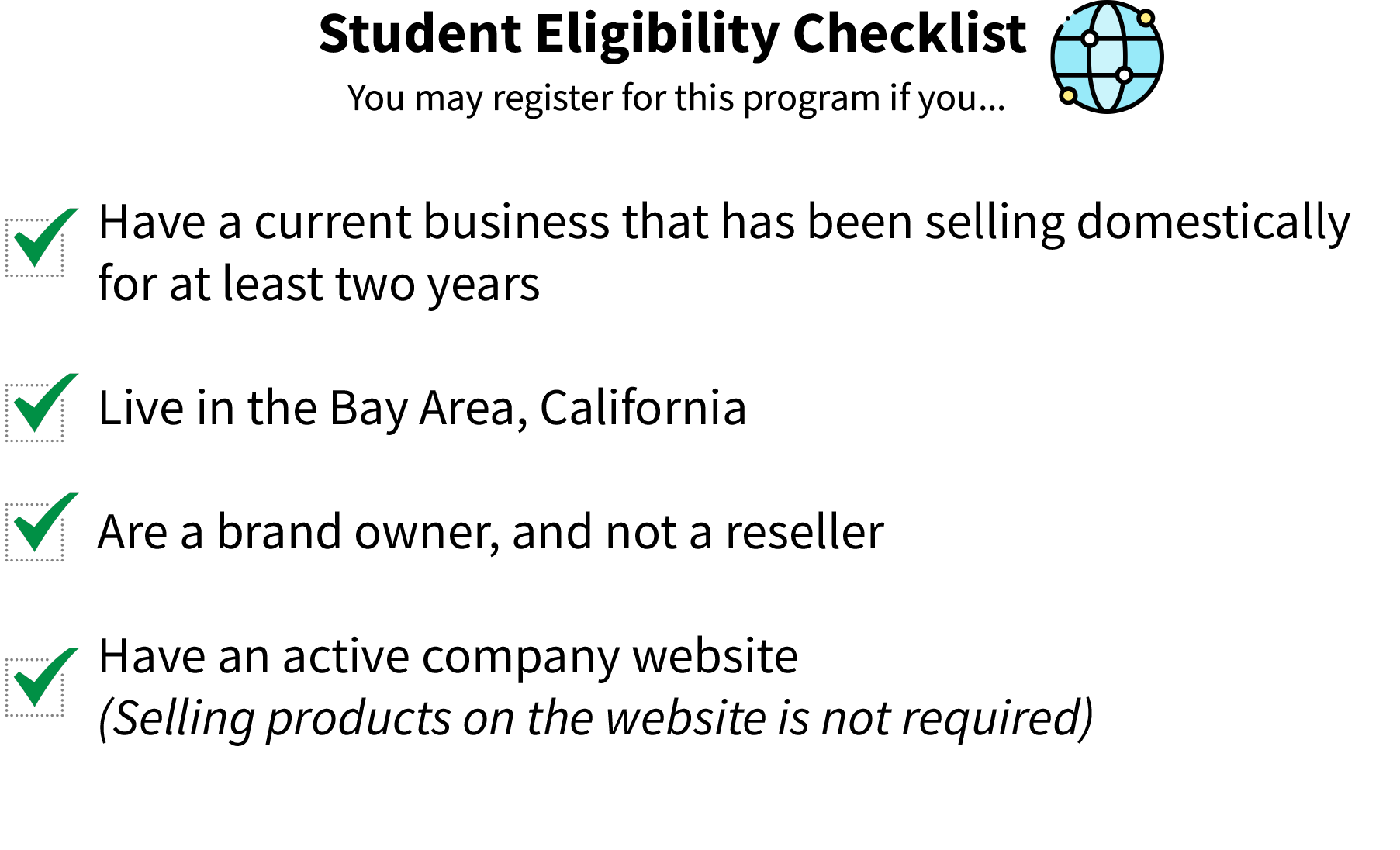October 4, 2022 - December 15, 2022Online Program for Bay Area Residents |
Tuesdays & Thursdays: 6pm - 7:30pm Registration: $299 |
Why go Global?
Cross-border eCommerce and Trade are vital business components that can ensure sustainability for entrepreneurs when societal changes threaten the consumer marketplace. In fact, 95% of the world’s buying power exists overseas (U.S. Commercial Service, 2021). California is home to 4.1 million small businesses, which represents 99.8% of all businesses in the state. Additionally, small businesses are California’s number one employer. Exporting helps companies expand and grow financially, but also hire more employees, typically at higher salaries. Join our 4 month program taught by experienced industry experts to enhance both workforce and economic development. Register Now! |
 |
Trade Incubator for Global Entrepreneurship at Cañada College
Program Overview
This program will train business owners to enter the international market place through a 5-part trade course taught by industry experts. By the end of the course, students will have completed an Export Plan which is needed to obtain comprehensive support from the U.S. Commercial Service. Trade elements taught in the course will include eCommerce, Logistics & Supply Chain, Global Markets & Digital Marketing, Export Financing, and Regulations & Compliance
 |
 |
What you will Learn
This program will train business owners to enter the international market through a 5-part trade course taught by industry experts using a hybrid model of lecture and 1-on-1 advisement. By the end of the course, students are expected to complete a draft of their Export Plan that can be used in tandem with export activity, to receive comprehensive support from local and national agencies.
Program Sections
Overview:
A beginner’s guide to the ecosystem of eCommerce. The class is geared towards brand owners and manufacturers. Though the class information can also be useful for resellers, the information is aimed at helping companies that own the intellectual property rights of the brand they are selling. The class helps the brand owner identify the different methods of selling their products, and how to establish the best method of sales channel strategy. It also includes a Step by Step process of preparing their company to enter the eCommerce space
Student Learning Outcomes: (SLOs)
Upon successful completion of this class, a student will meet the following outcomes:
A. How to categorize their business type.
B. The basic terminology of eCommerce sales.
C. What they need to do to establish an eCommerce strategy, and how to execute that strategy.
Section Instructor: Perry Goldstein
Overview:
This class explains the role Master Distributors play as part of a sales channel strategy, and how they assist a U.S. company expand sales globally through eCommerce. The class covers basic industry terminology, sales procedures, and what to expect from a Master Distributor. The class also explains who the U.S. Commercial Services is, and how they can help a company find overseas distributors.
Student Learning Outcomes: (SLOs)
Upon successful completion of this course, a student will meet the following outcomes:
A. What a master Distributor is, and how to manage them as part of an eCommerce sales channel strategy.
B. The basic terminology of eCommerce sales.
C. How to use the U.S. Commercial Services to find international Master Distributors.
Section Instructor: Perry Goldstein
Overview:
Is exporting right for me? Of course, all businesses want to sell more, but exporting is often a scary and daunting journey for small businesses who do not have the right circle of support and strategy to market their goods abroad. The journey starts with evaluating the value proposition of exporting, determining a marketing plan, and assessing export readiness. The global marketing modules introduce global entrepreneurs to the opportunities and risks of exporting while equipping them with the tools and support required to succeed in the international marketplace
Student Learning Outcomes: (SLOs)
Upon successful completion of this course, a student will meet the following outcomes:
A. Understand the basic concepts and terminology needed to understand global marketing
B. Develop a marketing plan and assess export readiness
C. Describe key supply chain concepts within a variety of industries.
Section Instructor: Ruth Amanuel
Overview:
Evaluation and implementation of the drivers in the industry sectors of cost, competition, market and technology. These drivers are important to business owners who seek to actively export or import goods or are otherwise involved in international trade operations. All relevant issues are thoroughly explored, including documentation, terms of payment, terms of trade (Incoterms), customs clearance, transportation, and security issues.
Student Learning Outcomes: (SLOs)
Upon successful completion of this course, a student will meet the following outcomes:
A. Apply basic concepts and terminology needed to understand and perform basic logistics and trade operations services.
B. Identify the methods of entry into foreign Markets according to industry standards.
C. Describe key supply chain concepts within a variety of industries.
Section Instructor: Alpha Lewis
Overview:
Evaluation of the drivers in the industry sectors of Finance and Trade. These drivers are important to business owners who seek to actively export or import goods or are otherwise involved in international trade operations. All relevant issues are thoroughly explored, including payment methods and corresponding risks and mitigation strategies, common financing options, insurance and pricing.
Student Learning Outcomes: (SLOs)
Upon successful completion of this course, a student will meet the following outcomes:
A. Apply basic concepts and terminology needed to understand and use basic export finances and trade finance services.
B. Identify, contrast and compare payment methods and their impact on the business.
C. Describe key resource options for export financing.
D. Apply basic concepts to understand landed cost and its impact on profitability
Section Instructor: Bob Komoto
Overview:
Evaluation and implementation of the drivers in the industry sectors of cost, competition,
market and technology. These drivers are important to business owners who seek to
actively export or import goods or are otherwise involved in international trade operations.
All relevant issues are thoroughly explored, including documentation, terms of payment,
terms of trade (Incoterms), customs clearance, transportation, and security issues.
Student Learning Outcomes: (SLOs)
Upon successful completion of this course, a student will meet the following outcomes:
A. Apply basic concepts and terminology needed to understand and perform basic exporting and import regulations.
B. Identify the regulatory agencies that might be applicable to entering the foreign country.
Section Instructor: Fatima Guadamuz-Cabral
Register Now!
Student Pathway to Success
This course will develop the skill level of small business owners and create the groundwork for structural enhancements to their company. Entrepreneurs who are interested in furthering their education or the education of their employees can enroll in one of our robust AA or CA programs in the Business and Commerce Department.







